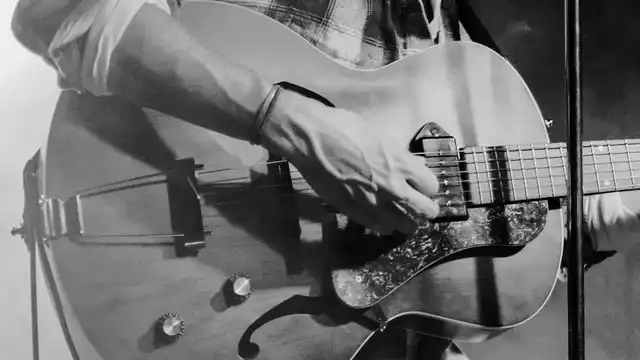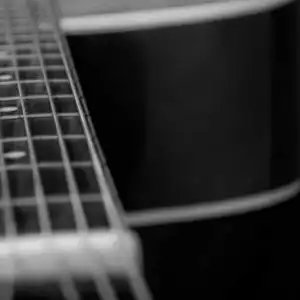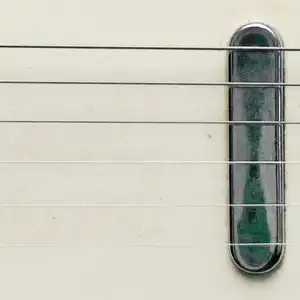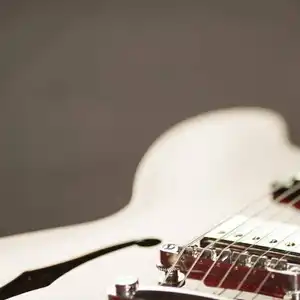Learning Jazz Guitar Scales: Beginner's Guide


The Basics that Underly Jazz Guitar Scales
To beginners, it can seem like there is almost a magical formula involved in creating a simple major scale but we are going to unravel that one right now. The major scale is a great place to start learning about scales. It is the simplest scale in terms of identifying which notes to use and is a great place to learn from as a jumping off point to other scales. There are no sharps or flats to worry about if we look strictly at the C major (M) scale as an example. If you look at a keyboard, you will see that only the white keys make-up the CM diatonic scale. The magical formula we intimated at earlier uses the white keys only as follows:The Diatonic CM Scale
 You will notice that there is no black key in between the E and the F or the B and the C. This is a half-step whereby the rest of the notes in the scale are tonally further apart (whole step) because of the extra note in between them.
This is the same on the guitar fretboard. The E and the F are right beside each other as are the B and the C while the rest of the notes on the fretboard have an extra fret in between them.
So, the formula is therefore: W-W-H-W-W-W-H and the good news is this never changes regardless of what key you play in. You will have to introduce sharps and flats to stay true to the formula as you progress to other keys, but the formula stays the same, as does your fingering on the fretboard.
You will notice that there is no black key in between the E and the F or the B and the C. This is a half-step whereby the rest of the notes in the scale are tonally further apart (whole step) because of the extra note in between them.
This is the same on the guitar fretboard. The E and the F are right beside each other as are the B and the C while the rest of the notes on the fretboard have an extra fret in between them.
So, the formula is therefore: W-W-H-W-W-W-H and the good news is this never changes regardless of what key you play in. You will have to introduce sharps and flats to stay true to the formula as you progress to other keys, but the formula stays the same, as does your fingering on the fretboard.
How Do I Play a Major Scale?
The best way to learn and play a major scale is to practice one scale at a time in all positions, not just all scales in one position. Playing in different positions in one sitting really builds a comfort zone with scales. Let’s say we want to play the C Major scale in what we can call the 6-2 position. The 6 means the sixth string and the 2 means you start playing the scale with the second finger on the sixth string whereby the finger always starts on the root note of the scale. It really helps to know the notes on the 6th and 5th strings to get your bearings. So, put your 2nd finger on G on the 6th string of the guitar (3rd fret) and we are ready to play the G major scale as seen in the fret diagram below. But first, here is a little trick.How Many Scale Positions do I have to Know?
The answer is at least seven. Many guitarists including me deem the following seven scale positions as the important ones. These seven scale positions in a string to finger relationship are:- 6-2
- 6-1
- 4-1
- 5-4
- 5-2
- 5-1
- 6-4
- 6-2 5-2
- 6-4 5-4
- 6-1 5-1 4-1
G Major Scale Starting on 6-2
 Position 5-2 is identical fingering as above except you start on the fifth string on the note of choice.
The unreadable fret numbers on the left are 3, 5 and 7.
Remember, you can start on any note on the 6th or 5th strings and still use this position anywhere on the fretboard.
The second group starts on the 4th finger. Let’s take a look at a CM starting on the eighth fret.
Position 5-2 is identical fingering as above except you start on the fifth string on the note of choice.
The unreadable fret numbers on the left are 3, 5 and 7.
Remember, you can start on any note on the 6th or 5th strings and still use this position anywhere on the fretboard.
The second group starts on the 4th finger. Let’s take a look at a CM starting on the eighth fret.
CM Scale 6-4

A little pinky stretch in that one.
AM Scale 6-1

Fingerings are applicable to 5-1 and 4-1 as well.
Scale Position Summary
The above fret diagrams show the position applicable to the each of the fingering groups. This allows you to play all seven positions of the major scale. Ensure that your thumb is behind the neck when playing these scales and fretting hand arched as if holding a ball in your palm. This will greatly aid you in proper technique for playing your guitar in general.Melodic Minor Scales
I know this feels like a lot of information but once you have mastered the major scale positions we have discussed, you basically already know the minor melodic scale positions because there is only a one-note difference. That difference is the third interval. That is the only difference between the major scale and the melodic minor scale. All you have to do is flatten the third in each scale position and you have the melodic minor scale. For example: CM scale is C, D, E, F, G, A, B. Melodic minor scale is C, D, Eb, F, G, A, B. And, to top that off...Top Secret
The majority of jazz music performed is in the major and melodic minor scales. So, by learning this information you will have really conquered a large portion of the jazz guitar scales right here. Enjoy, and remember to pace yourselves when doing scales because it can be easy to overdo it at first.Other Posts you may like

Guitar Strings Order: How the Guitar is Tuned and Why

Two Handed Tapping: Our Top 8 Tappers of All Time

Which Guitar Strings Wear Your Fret Wire Down More?

What is Nashville Tuning? Its History, Best Guitar Strings & Uses

Guitar Scale Length Explained: String Tension & Playability

What Guitar Strings I Used To Play...
0 Responses
Leave a Reply
Your email address will not be published. Required fields are marked *

